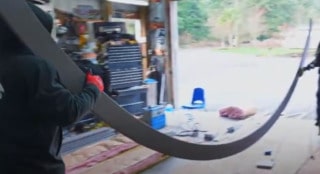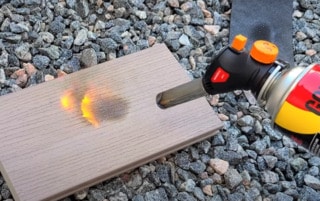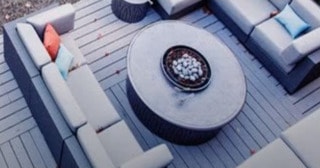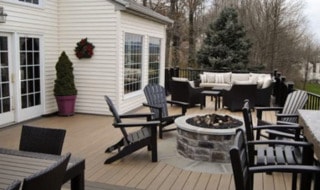Composite decks are one of the modern technical wonders that minimize the constant maintenance of a homeowner. However, are they able to take the abuse of wood deck wood? Specifically, will they withstand the Heat of a patio heater?
Composite wood can reach temperatures of 160F (71C) in direct sunshine. These temperatures can burn skin. Patio heaters are designed to reflect thermal energy toward people. Therefore they do not reach these temperatures away from the heat source. Therefore, a patio heater cannot harm composite decking adequately installed.
So, we know that a typical patio heater is safe on a composite deck, but what is unsafe for your decking?
What Would Make a Heater Unsafe on Composite
The plastic within the composite decking makes it more dense. It, therefore, has a greater capacity to transfer and store heat. However, if the sunshine can get it to the temperatures of 160 degrees Fahrenheit, that in short means it is designed for that temperature. So, what temperatures would be bad or composite?
What Temperature is Unsafe for Composite
To achieve this, let’s look at it this way. What would get to temps over 160F (71C)? Only a direct flame or a heater too close to the composite decking can reach temperatures over 160F.

So, patio tower heaters should be good. They are designed to not work if not in an upright vertical position. This is pretty much the same thing for infrared heaters. They are designed to perform a certain way and only upset; modified units will achieve temperatures over our target temp.
They heat heat composite decking to over 300F (149C) more an average temperature around 350F (176C) to make the custom bend and arcs on decks.
It is different per each company but somewhere over 200F (93C) unrecoverable deformation may occur
What Heat Type is Unsafe for Wood Decking
Open-source flames are the only heat source that could harm your composite deck. I imagine you are smart enough to not build a wood fire on top of your composite deck? Because that would damage it, melt it, and probably catch it, or the wood structure underneath the decking on fire.

A natural wood fire-pit set up off the deck can still reach temperatures over 160F a foot or 2 away from the decking. Anything in a real wood fire pit unless you place a protective barrier will damage the decking.
What Can You Use on Wood or Composite Decking?
Gas-powered fire pits are typically self-contained units and do not have heat dissipation like a real wood fire. In other words, gas fires are not as hot and do not create infrared heat rays as natural wood does.

Plus, gas fire pits are designed to keep heat from going down. So, a gas-powered fire pit is typically OK on top of your composite decking.
Want Real Wood Fire on a Wood or Composite Deck
They do make a protective barrier NASA cloth that you can put down. I would do it this way.
Place the cloth down where you want your fire pit. Buy some flat stone or tiles to create a protective barrier on top of the fabric. I recommend at least 2 feet bigger than the Firepit is. So, a fire pit ring that is 30″ in diameter requires a 78″ diameter stone barrier, or square.
The more significant area is because real wood has sparks and embers that can pop off and mark the composite decking material.
Click here to check out the fire and heat barrier cloth. Here are some easy-to-make stone fire pit areas.
What Differences Between Wood and Composite for Heaters Are There?
The main problem that comes to my mind is the fact composite has no real structural integrity. It has even less as it gets warmer or hotter. Therefore, many manufactures suggest 12” centers on their composites to maintain a reasonable pounds per square inch PSI support without warping or deflecting.
Wood does not melt, it can catch fire, but it won’t melt. As touched on above, it will maintain structural integrity until enough of it burns to lose that integrity. Plus, if you see your deck on fire, you know something is wrong. (or, at least, I hope so?)
Also, Wood, Pressure-treated pine, absorbs less heat in the day from the sun. However, much depends on the color of the stain used as to what temperatures are achieved.
What Are the Main Things that Make a Heater Unsafe for Any Deck?
To answer this, it is probably best to break it down to the typical problems that could possibly happen.
The heater is set up too close to the house, and it melts the vinyl siding or blisters the paint.
The heater is set too close to chairs with plastic webbing. Also, too close to metal chairs of dark colors can burn bare skin when someone sits back down.
The heater is too close to the patio light strings and perhaps even touching the outer shield.
These are the simple little things that could happen, and just being aware of them can solve the problem before it happens. If you noticed, it is usually because it is set too close!
What tool can help you keep track of the safe temperatures for your decking
Yes, there is one tool that can help you gauge the temperature of your decking, siding, chair backs for bare feet, heater output, or just trying to appease Aunt Edna.
It is a simple Infrared laser temperature probe. They are a lifesaver rather than trying to guess a temp. You can get scientific and say, “yes, Hun, it is safe and not hot enough to melt!”
Here is the one I use available at Amazon. I use it to check the temp on the vinyl siding when we have heaters on and close.
Need More?
I hope this solved your question about heaters and your composite decking. Look for our article on what temperature ranges top composite decking can get compared to wood coming in the future.
Meanwhile, maybe these articles may be of interest to you?



